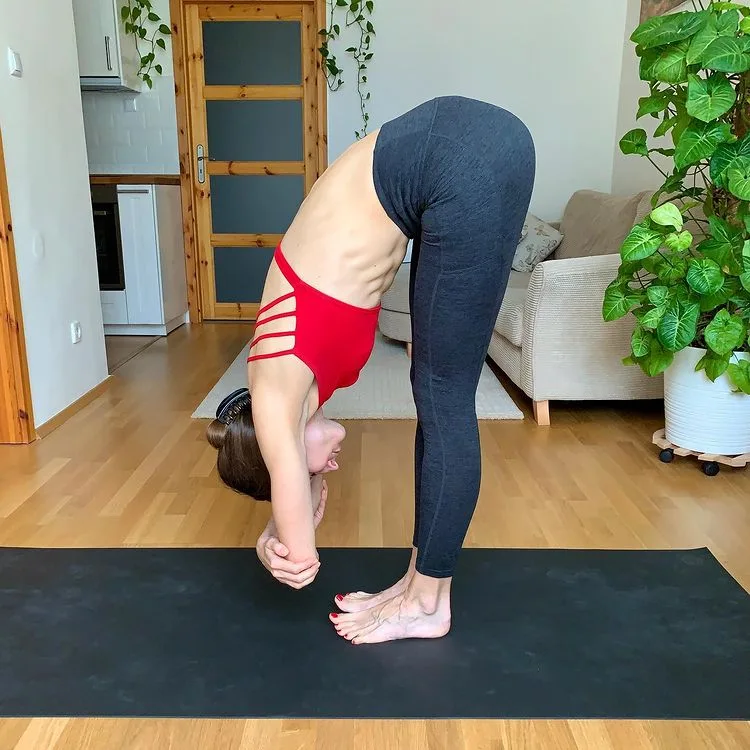Ragdoll Pose, also known as Dangling Pose or Baddha Hasta Uttanasana, stretches the spine, hamstrings, and calves while strengthens the stomach, diaphragm, liver, kidneys, intestines, feet, and thighs.
In this posture the urinary bladder meridian is greatly affected. This variation of the Standing Forward Bend Pose is considered good for the liver, spleen and kidneys.
Information
| Known as: | Ragdoll Pose, Uttanasana Variation Hands to Elbows, Baddha Hasta Uttanasana, Standing Forward Fold Pose Variation Hands to Elbows, Dangling Pose, Yin Yoga Dangling Pose |
| Sanskrit name: | बद्ध हस्त उत्तानासन |
| IAST: | baddha hāsta uttānāsana |
| Pronunciation: | BAH-dah hah-stah OOT-tan-AHS-anna |
| Type: | Forward-bend, inversion, stretching, standing poses |
| Level: | Beginner |
| Focus: | Hamstrings, calves, knees, neck |
| Total time: | 30 to 90 seconds |
| Drishti: | Third Eye (Bhrumadhye) |
| Chakra: | Sahasrara Chakra, Ajna Chakra, Swadisthana Chakra, Muladhara Chakra |
| Indications: | Lower back, spine, sinuses, neck pain, digestion, urinary bladder, liver, spleen, kidneys, balance the doshas (Pitta and Kapha), headaches, mild depression, stress, insomnia |
| Counterpose: | Mountain Pose (Tadasana), Child’s Pose (Balasana), Savasana (Corpse Pose) |
| Preparatory poses: | Downward-facing dog pose (Adho mukha shvanasana), Upward/half forward fold pose (Ardha uttanasana), Head-to-knee pose (Janu sirsasana), Seated forward bend pose (Paschimottanasana), Reclined hand to toe pose (Supta padangusthasana) |
| Follow-up poses: | Upavistha Konasana (Wide-angle seated forward bend pose), Ardha uttanasana (Standing half forward bend pose), Paschimottanasana (Intense dorsal stretch pose) |
| Contraindications: | Back or neck injury, pregnant women |
Meaning
Baddha Hasta Uttanasana is derived from the Sanskrit name, which is made up of five words – Baddha + Hasta+ Ut + Tan + Asana:
- “Baddha” = “bound”
- “Hasta” = “hand”
- “Ut” = “intense (particle indicating deliberation, intensity)”
- “Tan” = “to stretch or extend or lengthen out”
- “Asana” = “pose or posture”
The word ‘Dangling’ is known ‘Latakna’ in Hindi and it resembles anything that hangs. In yoga, this is a pose also known as Baddha Hasta Uttanasana.
Benefits of Ragdoll Pose
The physical and mental benefits of this yoga pose are listed below:
- Physical Benefits:
- Stretches the spine, hamstrings and calves
- Strengthens the stomach, diaphragm, liver, kidneys, intestines, feet, and thighs
- Opens the hips and groins
- Improves the function of the internal organs
- Improves the digestion
- Improves the flexibility of the hamstrings and spine
- Stimulates the reproductive organs
- Helps women during menopausal and menstruation times
- Relieves the headache, insomnia, and fatigue
- Reduces the lower back and neck pain
- Alleviates discomfort from sinusitis
- Soothes the nervous system
- Mental Benefits:
- Calms the mind
- Reduces the stress
- Relieves mild depression
- Relieves anxiety
Ragdoll Pose Practice Guide
In this pose, the torso is tilted forward from the lower back and allowed to hang freely. The pose stretches the body and results in inversion. This yoga pose is a variant of Uttanasana or Standing Forward Bend Pose in which the hands touch the floor.
Step-by-step instructions
- Begin in Tadasana (Mountain Pose) on the mat, keeping feet shoulder-width apart.
- Grasp the elbows with opposite palms and roll your shoulders back and open your chest straight.
- Inhale and while exhaling bend forward according to the flexibility. Make sure the knees and back remain straight.
- Maintain your posture with normal breathing for as long as is comfortable.
- Feel free to speak in a posture or move your head, neck, and shoulders to release any tension.
- You can continue to hold the opposite elbow, or you can try the following variations:
- Release the grip and let your fingers grasp the mat.
- Interlace fingers behind your body. Squeeze palms together at wrists and place micro-bends in elbows.
- Begin to move the hands away from the body to open the shoulders.
- Place the fingers on the back of the head where the head and neck meet. This allows for greater release in your neck, spine and upper back.
Precautions and contraindications
You should be aware of the precautions and contraindications with the practice of Ragdoll Pose (Dangling Pose) and avoid it when needed. Some precautions, which are in addition to the contraindications of this yoga pose, are given below:
Lack of balance
Individuals who have lack of balance should avoid holding this pose for long periods of time, whereas hanging poses usually involve the body swinging back and forth, as there is no support to lean forward. You can use yoga blocks to support the hanging head as an alternative practice.
Neck and head pressure
If you feel the intensity of this pose on the neck and head, you may choose to look up rather than let your head hang down.
Pregnant women
Women who are pregnant should avoid the practice of this yoga pose as the internal organs contract due to the contraction of the abdominal muscles. Hence it is not safe for you practice this yoga pose.















